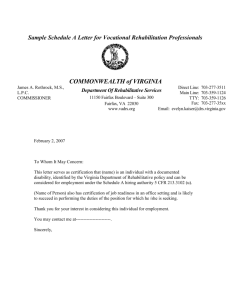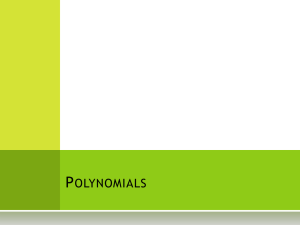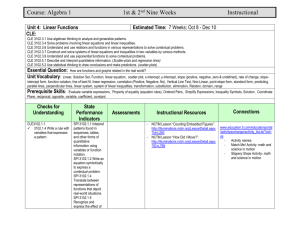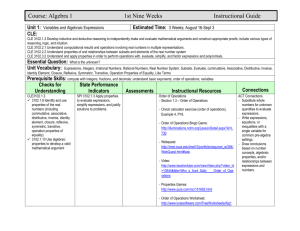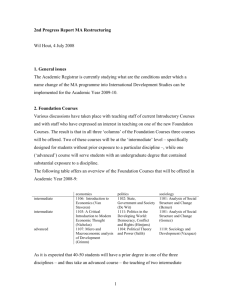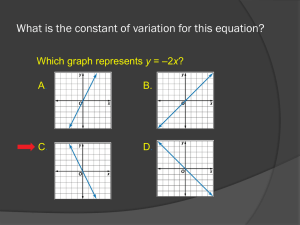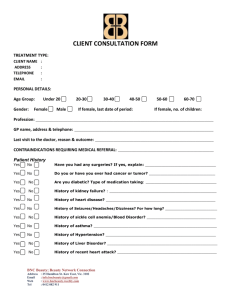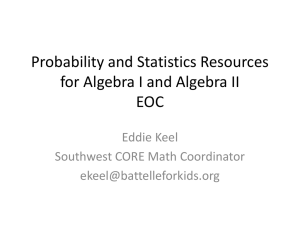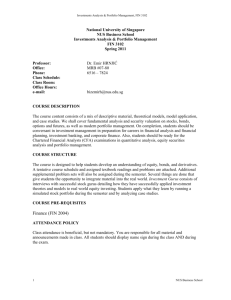Algebra I
advertisement
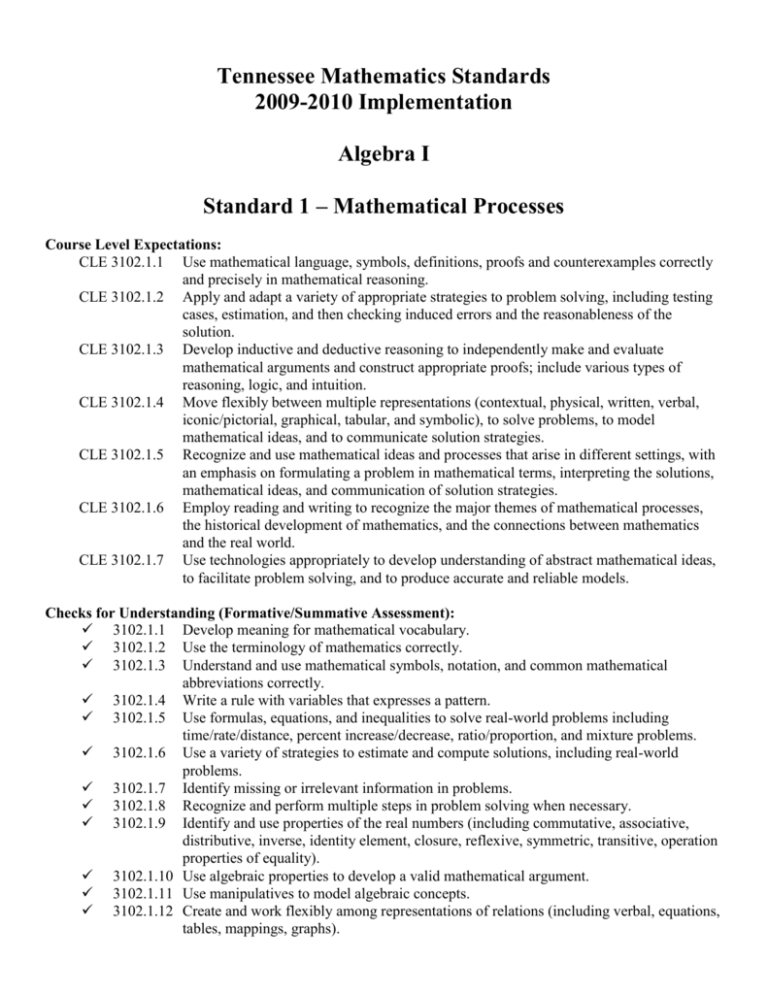
Tennessee Mathematics Standards 2009-2010 Implementation Algebra I Standard 1 – Mathematical Processes Course Level Expectations: CLE 3102.1.1 Use mathematical language, symbols, definitions, proofs and counterexamples correctly and precisely in mathematical reasoning. CLE 3102.1.2 Apply and adapt a variety of appropriate strategies to problem solving, including testing cases, estimation, and then checking induced errors and the reasonableness of the solution. CLE 3102.1.3 Develop inductive and deductive reasoning to independently make and evaluate mathematical arguments and construct appropriate proofs; include various types of reasoning, logic, and intuition. CLE 3102.1.4 Move flexibly between multiple representations (contextual, physical, written, verbal, iconic/pictorial, graphical, tabular, and symbolic), to solve problems, to model mathematical ideas, and to communicate solution strategies. CLE 3102.1.5 Recognize and use mathematical ideas and processes that arise in different settings, with an emphasis on formulating a problem in mathematical terms, interpreting the solutions, mathematical ideas, and communication of solution strategies. CLE 3102.1.6 Employ reading and writing to recognize the major themes of mathematical processes, the historical development of mathematics, and the connections between mathematics and the real world. CLE 3102.1.7 Use technologies appropriately to develop understanding of abstract mathematical ideas, to facilitate problem solving, and to produce accurate and reliable models. Checks for Understanding (Formative/Summative Assessment): 3102.1.1 Develop meaning for mathematical vocabulary. 3102.1.2 Use the terminology of mathematics correctly. 3102.1.3 Understand and use mathematical symbols, notation, and common mathematical abbreviations correctly. 3102.1.4 Write a rule with variables that expresses a pattern. 3102.1.5 Use formulas, equations, and inequalities to solve real-world problems including time/rate/distance, percent increase/decrease, ratio/proportion, and mixture problems. 3102.1.6 Use a variety of strategies to estimate and compute solutions, including real-world problems. 3102.1.7 Identify missing or irrelevant information in problems. 3102.1.8 Recognize and perform multiple steps in problem solving when necessary. 3102.1.9 Identify and use properties of the real numbers (including commutative, associative, distributive, inverse, identity element, closure, reflexive, symmetric, transitive, operation properties of equality). 3102.1.10 Use algebraic properties to develop a valid mathematical argument. 3102.1.11 Use manipulatives to model algebraic concepts. 3102.1.12 Create and work flexibly among representations of relations (including verbal, equations, tables, mappings, graphs). 3102.1.13 Change from one representation of a relation to another representation, for example, change from a verbal description to a graph. 3102.1.14 Apply graphical transformations that occur when changes are made to coefficients and constants in functions. 3102.1.15 Apply arithmetic concepts in algebraic contexts. 3102.1.16 Understand and express the meaning of the slope and y-intercept of linear functions in real-world contexts. 3102.1.17 Connect the study of algebra to the historical development of algebra. 3102.1.18 Translate syntax of technology to appropriate mathematical notation. 3102.1.19 Recognize and practice appropriate use of technology in representations and in problem solving. 3102.1.20 Estimate solutions to evaluate the reasonableness of results and to check technological computation. State Performance Indicators: SPI 3102.1.1 Interpret patterns found in sequences, tables, and other forms of quantitative information using variables or function notation. SPI 3102.1.2 Write an equation symbolically to express a contextual problem. SPI 3102.1.3 Apply properties to evaluate expressions, simplify expressions, and justify solutions to problems. SPI 3102.1.4 Translate between representations of functions that depict real-world situations. SPI 3102.1.5 Recognize and express the effect of changing constants and/or coefficients in problem solving. SPI 3102.1.6 Determine and interpret slope in multiple contexts including rate of change in real-world problems. Standard 2 – Number & Operations Course Level Expectations: CLE 3102.2.1 Understand computational results and operations involving real numbers in multiple representations. CLE 3102.2.2 Understand properties of and relationships between subsets and elements of the real number system. Checks for Understanding (Formative/Summative Assessment): 3102.2.1 Recognize and use like terms to simplify expressions. 3102.2.2 Apply the order of operations to simplify and evaluate algebraic expressions. 3102.2.3 Operate with and simplify radicals (index 2, 3, n) and radical expressions including rational numbers and variables in the radicand. 3102.2.4 Operate efficiently with both rational and irrational numbers. 3102.2.5 Perform operations with numbers in scientific notation (multiply, divide, powers). 3102.2.6 Use appropriate technologies to apply scientific notation to real-world problems. 3102.2.7 Identify the subsets in the real number system and understand their relationships. 3102.2.8 Use multiple strategies to approximate the value of an irrational number including irrational square roots and including location on the real number line. State Performance Indicators: SPI 3102.2.1 Operate (add, subtract, multiply, divide, simplify, powers) with radicals and radical expressions including radicands involving rational numbers and algebraic expressions. SPI 3102.2.2 Multiply, divide, and square numbers expressed in scientific notation. SPI 3102.2.3 Describe and/or order a given set of real numbers including both rational and irrational numbers. Standard 3 – Algebra Course Level Expectations: CLE 3102.3.1 Use algebraic thinking to analyze and generalize patterns. CLE 3102.3.2 Understand and apply properties in order to perform operations with, evaluate, simplify, and factor expressions and polynomials. CLE 3102.3.3 Understand and apply operations with rational expressions and equations. CLE 3102.3.4 Solve problems involving linear equations and linear inequalities. CLE 3102.3.5 Manipulate formulas and solve literal equations. CLE 3102.3.6 Understand and use relations and functions in various representations to solve contextual problems. CLE 3102.3.7 Construct and solve systems of linear equations and inequalities in two variables by various methods. CLE 3102.3.8 Solve and understand solutions of quadratic equations with real roots. CLE 3102.3.9 Understand and use exponential functions to solve contextual problems. Checks for Understanding (Formative/Summative Assessment): 3102.3.1 Recognize and extend arithmetic and geometric sequences. 3102.3.2 Explore patterns including Pascal’s Triangle and the Fibonacci sequence. 3102.3.3 Justify correct results of algebraic procedures using extension of properties of real numbers to algebraic expressions. 3102.3.4 Simplify expressions using exponent rules including negative exponents and zero exponents. 3102.3.5 Add, subtract, and multiply polynomials including squaring a binomial. 3102.3.6 Find the quotient of a polynomial and a monomial. 3102.3.7 Use various models (including area models) to represent products of polynomials. 3102.3.8 Find the GCF of the terms in a polynomial. 3102.3.9 Find two binomial factors of a quadratic expression. 3102.3.10 Add, subtract, multiply, and divide rational expressions and simplify results. 3102.3.11 Solve multi-step linear equations with one variable. 3102.3.12 Recognize and articulate when an equation has no solution, a single solution, or all real numbers as solutions. 3102.3.13 Solve multi-step linear inequalities with one variable and graph the solution on a number line. 3102.3.14 Solve absolute value equations and inequalities (including compound inequalities) with one variable and graph their solutions on a number line. 3102.3.15 Determine domain and range of a relation and articulate restrictions imposed either by the operations or by the real life situation that the function represents. 3102.3.16 Determine if a relation is a function from its graph or from a set of ordered pairs. 3102.3.17 Recognize “families” of functions. 3102.3.18 Analyze the characteristics of graphs of basic linear relations and linear functions including constant function, direct variation, identity function, vertical lines, absolute value of linear functions. Use technology where appropriate. 3102.3.19 Explore the characteristics of graphs of various nonlinear relations and functions including inverse variation, quadratic, and square root function. Use technology where appropriate. 3102.3.20 Understand that a linear equation has a constant rate of change called slope and represent slope in various forms. 3102.3.21 Determine the equation of a line using given information including a point and slope, two points, a point and a line parallel or perpendicular, graph, intercepts. 3102.3.22 Express the equation of a line in standard form, slope-intercept, and point-slope form. 3102.3.23 Determine the graph of a linear equation including those that depict contextual situations. 3102.3.24 Interpret the changes in the slope-intercept form and graph of a linear equation by looking at different values of the parameters, m and b. 3102.3.25 Find function values using f(x) notation or graphs. 3102.3.26 Graph linear inequalities on the coordinate plane and identify regions of the graph containing ordered pairs in the solution. 3102.3.27 Determine the number of solutions for a system of linear equations (0, 1, or infinitely many solutions). 3102.3.28 Solve systems of linear equations graphically, algebraically, and with technology. 3102.3.29 Solve contextual problems involving systems of linear equations or inequalities and interpret solutions in context. 3102.3.30 Solve quadratic equations using multiple methods: factoring, graphing, quadratic formula, or square root principle. 3102.3.31 Determine the number of real solutions for a quadratic equation including using the discriminant and its graph. 3102.3.32 Recognize the connection among factors, solutions (roots), zeros of related functions, and x-intercepts in equations that arise from quadratic functions. 3102.3.33 Recognize data that can be modeled by an exponential function. 3102.3.34 Graph exponential functions in the form y = a(bx) where b 0. 3102.3.35 Apply growth/decay and simple/compound interest formulas to solve contextual problems. State Performance Indicators: SPI 3102.3.1 Express a generalization of a pattern in various representations including algebraic and function notation. SPI 3102.3.2 Operate with polynomials and simplify results. SPI 3102.3.3 Factor polynomials. SPI 3102.3.4 Operate with, evaluate, and simplify rational expressions including determining restrictions on the domain of the variables. SPI 3102.3.5 Write and/or solve linear equations, inequalities, and compound inequalities including those containing absolute value. SPI 3102.3.6 Interpret various relations in multiple representations. SPI 3102.3.7 Determine domain and range of a relation, determine whether a relation is a function and/or evaluate a function at a specified rational value. SPI 3102.3.8 Determine the equation of a line and/or graph a linear equation. SPI 3102.3.9 Solve systems of linear equation/inequalities in two variables. SPI 3102.3.10 Find the solution of a quadratic equation and/or zeros of a quadratic function. SPI 3102.3.11 Analyze nonlinear graphs including quadratic and exponential functions that model a contextual situation. Standard 4 – Geometry & Measurement Course Level Expectations: CLE 3102.4.1 Use algebraic reasoning in applications involving geometric formulas and contextual problems. CLE 3102.4.2 Apply appropriate units of measure and convert measures in problem solving situations. Checks for Understanding (Formative/Summative Assessment) 3102.4.1 Using algebraic expressions solve for measures in geometric figures as well as for perimeter, area, and volume. 3102.4.2 Use the Pythagorean Theorem to find the missing measure in a right triangle including those from contextual situations. 3102.4.3 Understand horizontal/vertical distance in a coordinate system as absolute value of the difference between coordinates; develop the distance formula for a coordinate plane using the Pythagorean Theorem. 3102.4.4 Develop the midpoint formula for segments on a number line or in the coordinate plane. 3102.4.5 Use dimensional analysis to convert rates and measurements both within a system and between systems and check the appropriateness of the solution. State Performance Indicators: SPI 3102.4.1 Develop and apply strategies to estimate the area of any shape on a plane grid. SPI 3102.4.2 Solve contextual problems using the Pythagorean Theorem. SPI 3102.4.3 Solve problems involving the distance between points or midpoint of a segment. SPI 3102.4.4 Convert rates and measurements. Standard 5 – Data Analysis, Statistics, & Probability Course Level Expectations: CLE 3102.5.1 Describe and interpret quantitative information. CLE 3102.5.2 Use statistical thinking to draw conclusions and make predictions. CLE 3102.5.3 Understand basic counting procedures and concepts of probability. Checks for Understanding (Formative/Summative Assessment): 3102.5.1 Identify patterns or trends in data. 3102.5.2 Develop a meaning for and identify outliers in a data set and verify. 3102.5.3 When a set of data is changed, identify effects on measures of central tendency, range, and inter-quartile range. 3102.5.4 Explore quartiles, deciles, and percentiles of a distribution. 3102.5.5 Construct and interpret various forms of data representations, (including line graphs, bar graphs, circle graphs, histograms, scatter-plots, box-and-whiskers, stem-and-leaf, and frequency tables). 3102.5.6 Draw qualitative graphs of functions and describe a general trend or shape. 3102.5.7 Compare two data sets using graphs and descriptive statistics. 3102.5.8 Examine real-world graphical relationship (including scatter-plots) to determine type of relationship (linear or nonlinear) and any association (positive, negative or none) between the variables of the data set. 3102.5.9 Determine an equation for a line that fits real-world linear data; interpret the meaning of the slope and y-intercept in context of the data. 3102.5.10 Using technology with a set of contextual linear data to examine the line of best fit; determine and interpret the correlation coefficient. 3102.5.11 Use an equation that fits data to make a prediction. 3102.5.12 Use techniques (Venn Diagrams, tree diagrams, or counting procedures) to identify the possible outcomes of an experiment or sample space and compute the probability of an event. 3102.5.13 Determine the complement of an event and the probability of that complement. 3102.5.14 3102.5.15 3102.5.16 3102.5.17 3102.5.18 Determine if two events are independent or dependent. Explore joint and conditional probability. Identify situations for which the Law of Large Numbers applies. Perform simulations to estimate probabilities. Make informed decisions about practical situations using probability concepts. State Performance Indicators: SPI 3102.5.1 Interpret displays of data to answer questions about the data set(s) (e.g., identify pattern, trends, and/or outliers in a data set). SPI 3102.5.2 Identify the effect on mean, median, mode, and range when values in the data set are changed. SPI 3102.5.3 Using a scatter-plot, determine if a linear relationship exists and describe the association between variables. SPI 3102.5.4 Generate the equation of a line that fits linear data and use it to make a prediction. SPI 3102.5.5 Determine theoretical and/or experimental probability of an event and/or its complement including using relative frequency.

